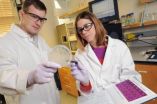(Press-News.org) UNIVERSITY PARK, Pa. -- As the emerald ash borer ravages North American ash trees, threatening the trees' very survival, a team of entomologists and engineers may have found a way to prevent the spread of the pests.
Emerald ash borers (EABs), a type of beetle native to Asia, first appeared in the U.S. about 20 years ago. They are now moving east from Michigan, killing ash trees on the Eastern Seaboard as far south as North Carolina.
"Within 25 years, practically no ash trees may remain on either side of the St. Lawrence Seaway," said Akhlesh Lakhtakia, Charles Godfrey Binder Professor of Engineering Science and Mechanics at Penn State.
As their name implies, emerald ash borers are iridescent green. The beetles don't carry disease, but their larvae feed on the ash trees' sap, effectively killing the trees by depriving trees of their nourishment.
Thomas C. Baker, Distinguished Professor of Entomology at Penn State, knew that the male EAB locates a mate by flying over an ash tree, finding a female by identifying her green wings, which are folded over her back, and then dropping straight down onto her.
Baker and a post-doctoral fellow in his lab, Michael J. Domingue, were using dead female EABs for bait to trap the male beetles. Dead EAB decoys are not ideal for trapping, said Baker, because they are fragile and can sometimes disappear from the trap.
Baker then learned that Lakhtakia was able to replicate certain biological materials, such as fly eyes and butterfly wings. Baker posed the question: could Lakhtakia's technique visually replicate the unique female borer to create a better lure?
The two researchers, working with a graduate student in Lakhtakia's lab, Drew P. Pulsifer, created a mold of the top of the female beetle's body. The decoy beetle is made by a process of layering polymers with different refractive indexes to create the desired iridescence, and then stamping the resulting material into the mold. The researchers were able to create a color similar to the emerald ash borer's green wings by layering different types of polymer. Eventually they were able to find the right combination of polymers and number of layers in order to refract light and create a color similar to the beetle's own iridescent green. The researchers' findings are scheduled to be published in the April issue of the Journal of Bionic Engineering.
"Akhlesh's technique allows us to present males with different visual stimuli," said Baker, also a faculty member in the University's Huck Institutes of the Life Sciences. "We can manipulate more than that, but right now we are experimentally manipulating the visual decoy."
The researchers had planned a pilot test in central Pennsylvania, but were unable to carry it out due to unfavorable regional weather conditions. They also ran a pilot test in Hungary with a related beetle pest that bores into oak trees. The pilot in Hungary used two controls -- a dead EAB and a decoy made of the polymers, but not molded into the shape of a beetle -- and three types of stamped decoys: one lightly stamped, another with medium force and the final stamped heavily.
"The preliminary indication is that these stamped decoys were 40 percent better than recently dead females in luring and then trapping the males," said Lakhtakia.
The stamped decoys are relatively easy to mass produce, making them both easier to create and maintain and more successful at trapping males than dead female borers.
The purpose of the decoys is to trap the males so that populations of emerald ash borers can be detected in new locations quickly, paving the way for efficient use of other control methods, according to the researchers.
"This is a small dataset, but very encouraging," said Baker, who plans to test the decoys in the U.S. this summer.
INFORMATION:
Other members of the research team were Beverly G. Post, engineering science and mechanics undergraduate, Penn State; Mahesh S. Narkhede, plastics engineering graduate student and member of the Center for Advanced Materials, and Jayant Kumar, professor of physics and applied physics and director of the Center for Advanced Materials, both at University of Massachusetts Lowell; and Raúl J. Martín-Palma, professor of applied physics, Universidad Autónomia de Madrid, Spain.
The U.S. Department of Agriculture supported this research.
**vmi**
Decoys could blunt spread of ash-killing beetles
2013-02-15
ELSE PRESS RELEASES FROM THIS DATE:
Poor stress responses may lead to obesity in children
2013-02-15
UNIVERSITY PARK, Pa. -- Children who overreact to stressors may be at risk of becoming overweight or obese, according to researchers at Penn State and Johns Hopkins University.
"Our results suggest that some children who are at risk of becoming obese can be identified by their biological response to a stressor," said Lori Francis, associate professor of biobehavioral health. "Ultimately, the goal is to help children manage stress in ways that promote health and reduce the risks associated with an over- or under-reactive stress response."
Francis and her colleagues ...
A smoking gun in lung cancer epigenetics
2013-02-15
Recent studies have identified correlations between cigarette smoke-induced microRNA (miRNA) expression and different aspects of lung cancer; however, it is unclear how miRNA expression directly contributes to carcinogenesis. MiRNAs regulate the expression of target genes and can have a significant impact on when and how well different gene products are expressed. In this issue of the Journal of Clinical Investigation, David Schrump and colleagues at the National Cancer Institute in Bethesda, MD, measured miRNA expression in normal human lung cells exposed to cigarette ...
Increased heart attack-related mortality in diabetics linked to protein oxidation
2013-02-15
Diabetic patients are more than twice as likely to die from a heart attack as non-diabetic patients, but the mechanisms that underlie increased heart attack-related mortality in diabetic patients are unknown. High levels of the oxidized form of the protein CamKII (ox-CaMKII) have been linked to increased risk of sudden death after heart attack. Additionally, hearts from diabetic patients have significantly greater ox-CAMKII compared to hearts from non-diabetic patients. In this issue of the Journal of Clinical Investigation, Min Luo and colleagues at the University of Iowa ...
JCI early table of contents for Feb. 15, 2013
2013-02-15
A smoking gun in lung cancer epigenetics
Recent studies have identified correlations between cigarette smoke-induced microRNA (miRNA) expression and different aspects of lung cancer; however, it is unclear how miRNA expression directly contributes to carcinogenesis. MiRNAs regulate the expression of target genes and can have a significant impact on when and how well different gene products are expressed. In this issue of the Journal of Clinical Investigation, David Schrump and colleagues at the National Cancer Institute in Bethesda, MD, measured miRNA expression in normal ...
Most comprehensive report in 50 years on education of key scientists
2013-02-15
In the most comprehensive report in a half century, experts today described fundamental changes needed in the education of the scientists whose work impacts medicine, drug discovery and virtually every other discipline. The result of a year-long project of a presidential commission of the American Chemical Society (ACS), the world's largest scientific society, the report was the topic of a symposium here at the 2013 annual meeting of the American Association for the Advancement of Science (AAAS).
Although it concluded that the state of graduate education in the chemical ...
'The Scars of Human Evolution' briefing explores physical fallout from 2-footed walking
2013-02-15
From sore feet to backaches, blame it on human evolution.
"Because we are the only mammals to walk on two feet," says Bruce Latimer, an anthropologist from the Case Western Reserve University School of Dental Medicine.
Latimer will present "A Backache of Longstanding: An Evolutionary Perspective on the Human Vertebral Column" at the 2013 American Association for the Advancement of Science's annual meeting in Boston, Feb. 14-18. His talk will be featured in the session, "The Scars of Human Evolution."
Latimer and other panelists will explain how adapting to upright ...
The science of uncertainty in genomic medicine
2013-02-15
BOSTON - The notion of "personalizing" health care through the use of an individual's genetic code has attracted considerable enthusiasm and investment. Impressive examples, confirmed through formal studies of clinical validity and utility, suggest that we have only scratched the surface of applications to treat disease more precisely, identify risk factors for complex disease, and guide preventative measures.
As the cost of sequencing entire genomes falls, the opportunities for people around the world to take possession of their entire genetic code will proliferate. ...
Artificial platelets could treat injured soldiers on the battlefield
2013-02-15
When it comes to healing the terrible wounds of war, success may hinge on the first blood clot – the one that begins forming on the battlefield right after an injury.
Researchers exploring the complex stream of cellular signals produced by the body in response to a traumatic injury believe the initial response – formation of a blood clot – may control subsequent healing. Using that information, they're developing new biomaterials, including artificial blood platelets laced with regulatory chemicals that could be included in an injector device the size of an iPhone. Soldiers ...
NIH study shows big improvement in diabetes control over past decades
2013-02-15
More people are meeting recommended goals in the three key markers of diabetes control, according to a study conducted and funded by the National Institutes of Health and the Centers for Disease Control and Prevention.
The report, published online February 15 in Diabetes Care, shows that, from 1988 to 2010, the number of people with diabetes able to meet or exceed all three of the measures that demonstrate good diabetes management rose from about 2 percent to about 19 percent. Each measure also showed substantial improvement, with over half of people meeting each individual ...
Climate change's costly wild weather consequences
2013-02-15
CHAMPAIGN, Ill. — Throughout 2012, the United States was battered by severe weather events such as hurricanes and droughts that affected both pocketbooks and livelihoods. Research suggests that in the coming years, U.S. five-day forecasts will show greater numbers of extreme weather events, a trend linked to human-driven climate change.
Donald Wuebbles, a professor of atmospheric sciences at the University of Illinois at Urbana-Champaign, will discuss extreme weather in a presentation Feb. 15 at the annual meeting of the American Association for the Advancement of Science ...


